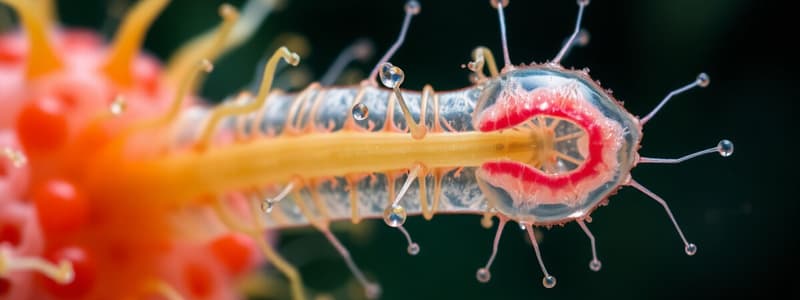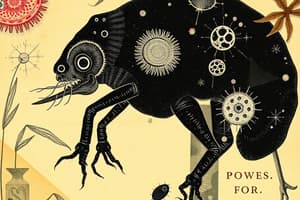Podcast
Questions and Answers
Which characteristic of living things refers to their ability to produce offspring?
Which characteristic of living things refers to their ability to produce offspring?
- Reproduction (correct)
- Nutrition
- Response
- Excretion
What is the primary function of the nucleus in both animal and plant cells?
What is the primary function of the nucleus in both animal and plant cells?
- To act as the control center (correct)
- To regulate waste disposal
- To store food
- To provide structural support
What distinguishes vertebrates from invertebrates?
What distinguishes vertebrates from invertebrates?
- Presence of excretion processes
- Presence of a backbone (correct)
- Ability to reproduce sexually
- Ability to respond to environmental stimuli
Which part of the plant cell is responsible for conducting photosynthesis?
Which part of the plant cell is responsible for conducting photosynthesis?
Which of the following represents a method through which living things get rid of waste?
Which of the following represents a method through which living things get rid of waste?
In terms of cell structure, what is a significant difference between animal and plant cells?
In terms of cell structure, what is a significant difference between animal and plant cells?
Which of the following groups includes organisms that are classified as non-vertebrates?
Which of the following groups includes organisms that are classified as non-vertebrates?
What is the role of the vacuole in plant cells?
What is the role of the vacuole in plant cells?
Which organism falls under the classification of fungi?
Which organism falls under the classification of fungi?
Flashcards
Living things
Living things
Organisms exhibiting characteristics like cells, nutrition, excretion, response, and reproduction.
Cells
Cells
Basic building blocks of all living things.
Animal cells
Animal cells
Cells with a membrane, nucleus, and cytoplasm.
Plant cells
Plant cells
Signup and view all the flashcards
Cell membrane
Cell membrane
Signup and view all the flashcards
Nucleus
Nucleus
Signup and view all the flashcards
Cytoplasm
Cytoplasm
Signup and view all the flashcards
Cell wall
Cell wall
Signup and view all the flashcards
Chloroplasts
Chloroplasts
Signup and view all the flashcards
Photosynthesis
Photosynthesis
Signup and view all the flashcards
Study Notes
Living Things and Cells
- Living things are distinguished from non-living things by specific characteristics.
- Key characteristics include cells, nutrition, excretion, response, and reproduction.
- Cells are the basic building blocks of all living things.
- Nutrition is the process of acquiring food for energy.
- Excretion is the process of getting rid of waste products.
- Response is the way living things react to changes in their surroundings.
- Reproduction is the way living things produce more living things.
Groups of Living Things
- Living things are grouped into various categories.
- Examples of living things include bacteria, fungi, plants, animals, and others.
- Vertebrates (animals with backbones) and invertebrates (animals without backbones) are two major groups of animals.
- Examples include horse, seagull, frog, snake, spider, earthworm, fly, and jellyfish.
Cells
- Living organisms are made of cells.
- Animal cells consist of a membrane, a nucleus, and cytoplasm.
- Plant cells, in addition to the components found in animal cells, possess a cell wall and a large vacuole and chloroplasts.
- The cell membrane regulates what enters and leaves the cell.
- The nucleus controls the cell's activities.
- Cytoplasm is where most cell activities occur.
- The cell wall provides structural support for plant cells.
- Vacuoles help in storing substances and maintaining cell pressure.
- Chloroplasts are responsible for photosynthesis in plant cells.
Animal Cells
- Animal cells consist of membrane (that regulates entrance and exit of substances), nucleus (controls cellular actions), and cytoplasm (for cell activities).
Plant Cells
- Plant cells, in addition to the components of animal cells, have a cell wall for structural support, vacuoles (for storage and pressure control), and chloroplasts (for photosynthesis).
Studying That Suits You
Use AI to generate personalized quizzes and flashcards to suit your learning preferences.
Related Documents
Description
This quiz explores the fundamental characteristics that distinguish living things from non-living things, focusing on cells and various life processes such as nutrition, excretion, response, and reproduction. It also covers the classification of living organisms, including examples of vertebrates and invertebrates. Test your knowledge on how living things are organized and their cellular structures.




